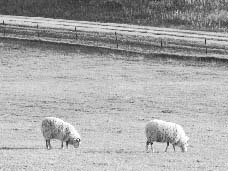
Drought
Like almost all of the other farmers around us, we were feeding hay in early July that year. We’d had no rain in weeks, and the grass was brown and brittle underfoot by midsummer. In a typical year, our sheep can thrive on pasture grass alone well into September or even early October. It was hard to watch Terry pitching forkful after forkful of this valuable commodity into the sheep feeders just after the fourth of July.
Not only was the pasture dried up and unproductive, it looked like we would be seriously short of hay for the coming winter. In desperation, Terry and I cut and baled everything that might be considered remotely palatable by the livestock, including patches of weeds, thistles, and the slough grass from a dried-up water hole. All of this yielded a mere fifty-five bales. Terry was worried.
The situation was the same for cattle and sheep producers throughout our area. Farmers were selling as many animals as they could. There simply wasn’t enough pasture for them, and there wouldn’t be enough hay to get them through the coming winter.
Terry hauled a trailer load of crossbred lambs to the auction barn in Fergus Falls in late July. We didn’t have enough pasture to feed them any longer.
An enclave of immigrants now lived in the Pelican Rapids area, and they were usually in the market for lamb meat. In recent years that had improved the price paid for our biggest crossbred lambs. But the price we got that July was pitiful. It barely paid for the gas to haul them to the sale. The livestock market was flooded with animals, and that drove the price down to rock bottom.
Our purebred Shetland lambs were valuable, but only if we could find the right buyers. The Icelandic crossbred lambs were usually sold as feeders—that is, for meat. For flocks yielding wool of hand-spinning quality, our area had no established market for selling either the wool or the lambs. To get better prices for our Shetland lambs, we would need to be far more visible in a larger marketplace. Breeders who got the top prices showed their sheep nationally and even internationally, and they were well known in the heritage sheep community. It takes a huge amount of time and travel to develop a presence in the nationwide market. Since our small flock had until recently been merely a hobby, we hadn’t made much effort in marketing either our wool or our breeding stock.
But even without advertising, every year we’d managed to sell some of our purebred Shetland lambs as breeding stock. Those buyers just seemed to be able to find us. A few of the crossbred lambs were sold to weavers or spinners or as lawn ornaments to retired farmers who just wanted to keep a few animals on a small acreage. One of my main objectives was to sell fewer lambs as feeders and more for breeding or wool producers. But in my first year of professional shepherding, we were forced to sell dozens of lambs to the slaughter market.